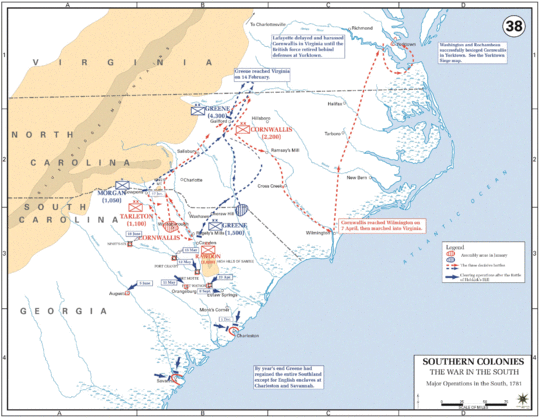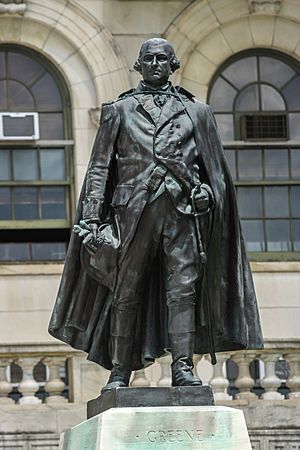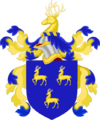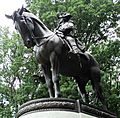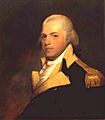Nathanael Greene facts for kids
Quick facts for kids
Nathanael Greene
|
|
|---|---|
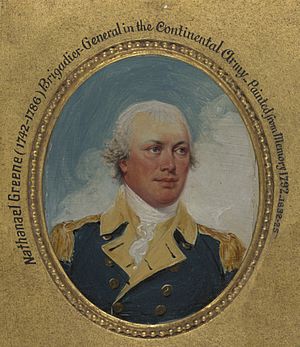
1792 portrait of Greene by John Trumbull
|
|
| Nickname(s) | "The Savior of the South" "The Fighting Quaker" |
| Born | August 7 [O.S. July 27] 1742 Warwick, Rhode Island |
| Died | June 19, 1786 (aged 43) Mulberry Grove, Georgia |
| Buried | |
| Allegiance | |
| Service/ |
Continental Army |
| Years of service | 1775–1783 |
| Rank | Major-General |
| Unit | Kentish Guards |
| Battles/wars | American Revolutionary War
See battles
|
| Spouse(s) | |
| Signature | |
Nathanael Greene (born August 7, 1742 – died June 19, 1786) was a very important American general during the American Revolutionary War. He was known for leading the American forces successfully in the southern parts of the war. Many people, including George Washington, thought he was one of the best and most reliable officers.
Contents
Early Life and Learning
Nathanael Greene was born on August 7, 1742, in Warwick, Rhode Island. His father, Nathanael Greene Sr., was a successful Quaker merchant and farmer. The family business was quite prosperous.
In 1770, Greene moved to Coventry, Rhode Island. He took over the family's iron foundry there. He also built a house called Spell Hall. Greene loved to read and built a large library. He studied military history, learning from famous leaders like Caesar and Frederick the Great.
Joining the Revolutionary War
In the early 1770s, Greene became active in opposing the British government's policies. He helped create a local militia group called the Kentish Guards.
After the Battles of Lexington and Concord in April 1775, Rhode Island formed its own army. Greene was chosen to lead it. Later that year, he became a general in the new Continental Army. This was the army fighting for American independence.
Greene's Role in Early Battles
Greene served directly under George Washington, the commander-in-chief. He fought in several major campaigns. These included the Boston campaign, the New York and New Jersey campaign, and the Philadelphia campaign.
After the Battle of Harlem Heights, Washington put Greene in charge of two important forts. These were Fort Lee in New Jersey and Fort Washington in New York. They were on opposite sides of the Hudson River.
While at Fort Lee, Greene set up supply points in New Jersey. These would later help the Continental Army during their retreats. Washington suggested that Greene remove the soldiers from Fort Washington because it was vulnerable. However, Greene decided to keep them there.
In November 1776, the British attacked Fort Washington. In the Battle of Fort Washington, the British captured the fort and about 3,000 American soldiers. Greene faced a lot of criticism for this loss. But Washington still trusted him and kept him in command.
Soon after, a British force captured Fort Lee. The Continental Army had to retreat across New Jersey into Pennsylvania. Greene led part of Washington's army in two important victories. These were the Battle of Trenton in December 1776 and the Battle of Princeton in January 1777.
Challenges and New Responsibilities
At the Battle of the Brandywine, Greene commanded a division in the middle of the American line. The British tried to surround the American forces. Greene's division helped prevent this, allowing the Americans to retreat safely.
The British captured Philadelphia after this battle. Washington then launched a surprise attack at the Battle of Germantown in October 1777. Greene's group arrived late, and the Americans lost this battle too. In December, Greene joined Washington's army at Valley Forge. They set up a winter camp there, about twenty-five miles from Philadelphia.
In March 1778, Greene took on a new, difficult job. He became the quartermaster general. This meant he was in charge of getting all the supplies for the Continental Army. It was a huge and often frustrating task.
He also commanded a division in the Battle of Monmouth. This battle lasted for hours and ended with no clear winner.
Leading the Southern Campaign

In October 1780, Washington gave Greene a very important command. He was to lead the Continental Army in the southern states. This area included Virginia, Georgia, and South Carolina.
When Greene took over, the British controlled key parts of Georgia and South Carolina. The southern state governments could not offer much help. Greene faced a strong British army of 6,000 men. This army was led by General Cornwallis.
Greene's army was smaller and lacked supplies. So, he chose a strategy of guerrilla warfare instead of big, direct battles. His goal was to stop the British from moving into North Carolina and Virginia. His plan relied on using riverboats and cavalry (soldiers on horseback) to outsmart and bother the British.
Greene achieved several important victories in the South. These included the Guilford Court House, Hobkirk's Hill, and Eutaw Springs. These wins helped weaken British control over the American South.
Major fighting on land mostly ended after Cornwallis surrendered at the siege of Yorktown in October 1781. However, Greene continued to serve in the Continental Army until late 1783.
Life After the War and Death
After the war, Greene moved to Georgia. He became a plantation owner, growing rice. However, his rice crops were not very successful.
Greene became sick on June 12, 1786. He died on June 19, 1786, at his home in Mulberry Grove. He was only 43 years old. Doctors said he died from sunstroke.
For over a hundred years, Greene's remains were buried in a vault in Colonial Park Cemetery in Savannah. In 1902, his remains were moved to a monument in Johnson Square in Savannah. Greene Square, a nearby public space, was named after him in 1799.
His Lasting Legacy
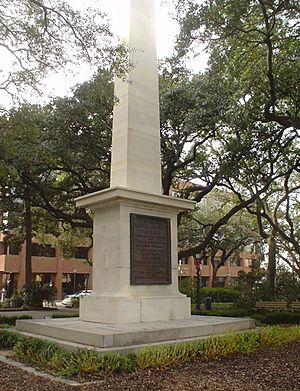
Nathanael Greene is remembered in many ways across the United States. In Washington, D.C., there is a bronze statue of him on horseback in Stanton Park.
A large painting of Greene hangs in the State Room of the Rhode Island State House. There is also a statue of him outside the building. A memorial stone, called a cenotaph, stands for him in Warwick, Rhode Island. Statues honoring Greene can also be found in or near Philadelphia, Valley Forge National Historical Park, Greensboro, North Carolina, Greensburg, Pennsylvania, and Greenville, South Carolina. The Nathanael Greene Monument in Savannah, Georgia, is where he is buried.
Many places and things in the United States are named after Greene. These include the Green River in Kentucky, Fort Greene Park in Brooklyn, and several schools. Several ships have also been named in his honor.
Personal Life
Nathanael Greene was married to Catharine Littlefield. They had their first child in 1776. Between 1777 and 1786, they had six more children.
Interesting Facts About Nathanael Greene
- Greene's father was a Quaker and did not encourage book learning, dancing, or other similar activities.
- As a teenager, Greene convinced his father to hire a tutor. He then studied subjects like mathematics, classic literature, law, and ideas from the Age of Enlightenment.
- Greene had a slight limp from childhood that stayed with him his whole life.
- His statue represents the state of Rhode Island in the National Statuary Hall Collection in the United States Capitol.
Images for kids
-
Painting by Charles Willson Peale
-
Monument to Greene at the Guilford Courthouse National Military Park in Greensboro, NC
-
Daniel Morgan, one of Greene's top commanders, led the Continental Army to victory at the Battle of Cowpens.
-
Henry "Light-Horse Harry" Lee commanded the Continental cavalry under Greene.
See also
 In Spanish: Nathanael Greene para niños
In Spanish: Nathanael Greene para niños
- Quakers in the American Revolution
- List of places named for Nathanael Greene


